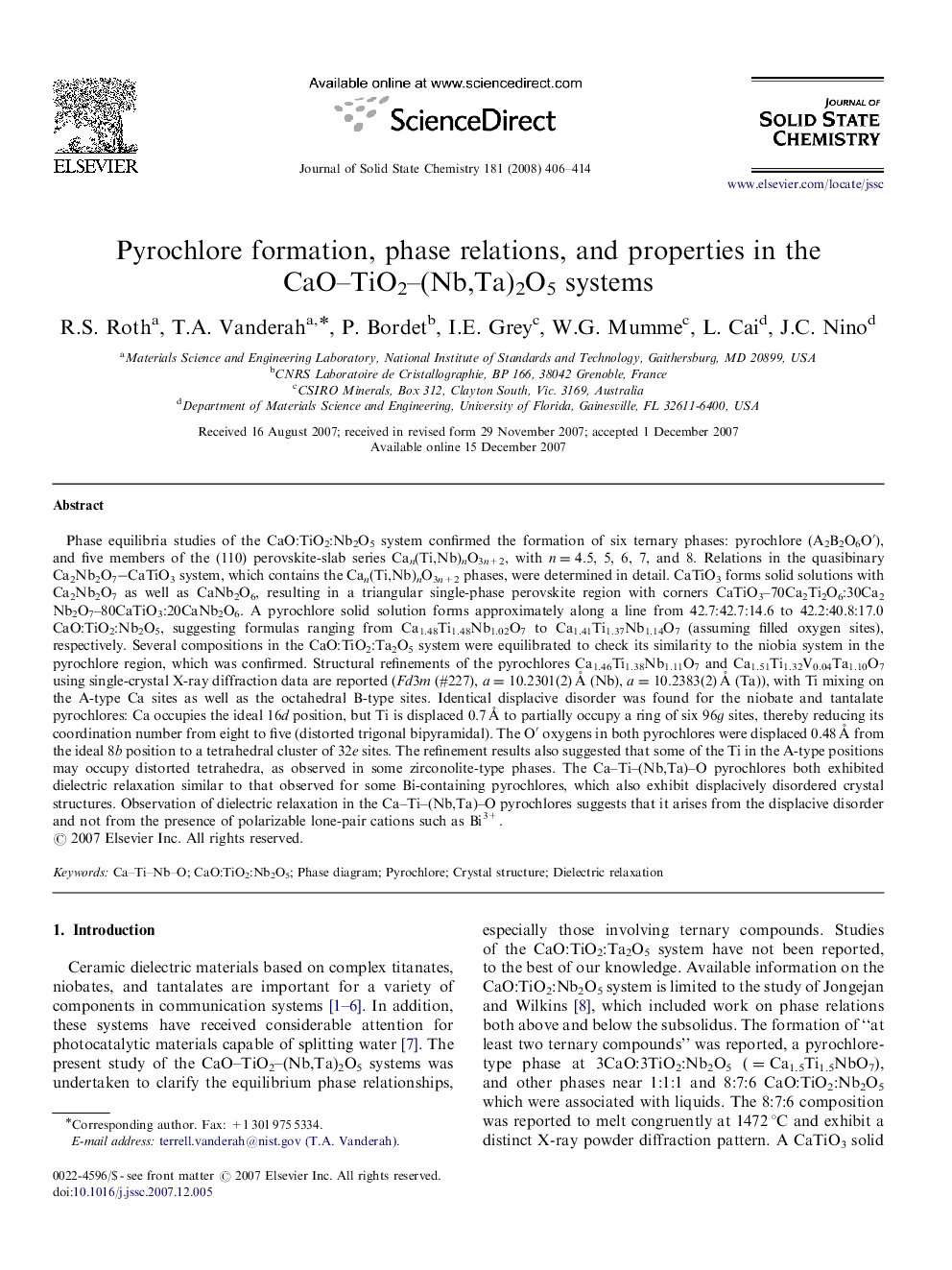| کد مقاله | کد نشریه | سال انتشار | مقاله انگلیسی | نسخه تمام متن |
|---|---|---|---|---|
| 1333704 | 979094 | 2008 | 9 صفحه PDF | دانلود رایگان |

Phase equilibria studies of the CaO:TiO2:Nb2O5 system confirmed the formation of six ternary phases: pyrochlore (A2B2O6O′), and five members of the (110) perovskite-slab series Can(Ti,Nb)nO3n+2, with n=4.5, 5, 6, 7, and 8. Relations in the quasibinary Ca2Nb2O7−CaTiO3 system, which contains the Can(Ti,Nb)nO3n+2 phases, were determined in detail. CaTiO3 forms solid solutions with Ca2Nb2O7 as well as CaNb2O6, resulting in a triangular single-phase perovskite region with corners CaTiO3–70Ca2Ti2O6:30Ca2Nb2O7–80CaTiO3:20CaNb2O6. A pyrochlore solid solution forms approximately along a line from 42.7:42.7:14.6 to 42.2:40.8:17.0 CaO:TiO2:Nb2O5, suggesting formulas ranging from Ca1.48Ti1.48Nb1.02O7 to Ca1.41Ti1.37Nb1.14O7 (assuming filled oxygen sites), respectively. Several compositions in the CaO:TiO2:Ta2O5 system were equilibrated to check its similarity to the niobia system in the pyrochlore region, which was confirmed. Structural refinements of the pyrochlores Ca1.46Ti1.38Nb1.11O7 and Ca1.51Ti1.32V0.04Ta1.10O7 using single-crystal X-ray diffraction data are reported (Fd3m (#227), a=10.2301(2) Å (Nb), a=10.2383(2) Å (Ta)), with Ti mixing on the A-type Ca sites as well as the octahedral B-type sites. Identical displacive disorder was found for the niobate and tantalate pyrochlores: Ca occupies the ideal 16d position, but Ti is displaced 0.7 Å to partially occupy a ring of six 96g sites, thereby reducing its coordination number from eight to five (distorted trigonal bipyramidal). The O′ oxygens in both pyrochlores were displaced 0.48 Å from the ideal 8b position to a tetrahedral cluster of 32e sites. The refinement results also suggested that some of the Ti in the A-type positions may occupy distorted tetrahedra, as observed in some zirconolite-type phases. The Ca–Ti–(Nb,Ta)–O pyrochlores both exhibited dielectric relaxation similar to that observed for some Bi-containing pyrochlores, which also exhibit displacively disordered crystal structures. Observation of dielectric relaxation in the Ca–Ti–(Nb,Ta)–O pyrochlores suggests that it arises from the displacive disorder and not from the presence of polarizable lone-pair cations such as Bi3+.
Crystal structures of the pyrochlores Ca1.46Ti1.38Nb1.11O7 and Ca1.51Ti1.32V0.04Ta1.10O7 were refined using single-crystal X-ray diffraction data. Both Ca2+ and Ti4+ occupy the A-type sites; Ca occupies the ideal 16d site and Ti is displaced 0.7 Å to partially occupy a ring of six 96g sites. The O′ oxygens are disordered among a tetrahedral cluster of 32e sites displaced 0.48 Å from the ideal 8b site. Both pyrochlores display dielectric relaxation similar to that observed for analogous Bi-based systems.Figure optionsDownload as PowerPoint slide
Journal: Journal of Solid State Chemistry - Volume 181, Issue 3, March 2008, Pages 406–414